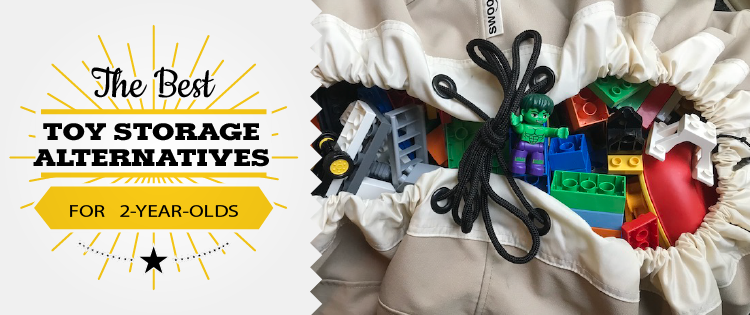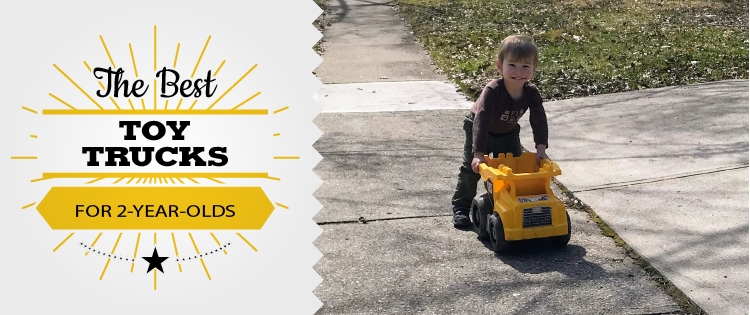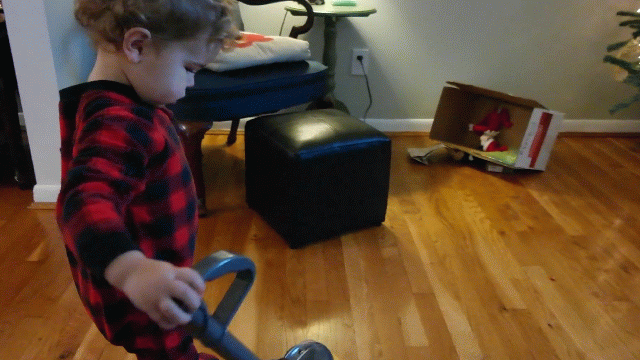Last Updated on July 1, 2022 by admin
As a new parent whose kid was starting to outgrow baby toys and acquire more and more toddler toys, I assumed I needed a toy box to store the growing collection. But with the benefit of hindsight, I can tell you that toy boxes are over-rated. There are much better toy storage alternatives available that make toys easier to access and easier to clean up. They’re lightweight, versatile, and pose no risk of smashing little fingers under a wooden lid.
Our Toy Box Mistake
I didn’t actually buy a toy box; it was technically a storage ottoman with a lid that could flip over and serve as a coffee table, too. It was about the same size as a toy box, though. It quickly filled up with plush talking animals, plastic toy telephones, electronic alphabet wheels, and wooden trucks.
It didn’t take long for me to notice some problems. Besides the fact that it filled up almost immediately, it also lent itself to being completely dumped out. After all, my 2-year-old was generally more interested in throwing toys than playing with them. Plus, the bin essentially encouraged kids to dig through all its contents. They often ended up removing the top layer of toys to get to the bottom layer.
The ottoman’s contents would slowly spread through the rest of the house before I could put it all back, resulting in about one toy per square foot in my home.
Plus, any smaller toys quickly filtered through to the bottom of the bin, rarely to be played with again.
A New Toy Organization Strategy
When I started feeling really overwhelmed by this problem, I took some time to think through my toy organization strategy. I broke it all down in this blog post.
Years later, I still stick with the few rules I came up with back when my kids were little:
- Limit toy storage to a few designated areas/rooms
- Occasionally take toys out of rotation
- Store the messiest toys where I can monitor them easily (in the playroom instead of the basement, for example)
- Organize toys by type so it’s easier to pare down each collection when necessary
That said, there’s still the question of exactly how to store the toys that you do decide to keep — and I don’t think a toy box is the best way.
Instead, consider a combination of the following toy storage alternatives.
Toy Storage Alternatives
An Accessible Toy Shelf
If you’re not familiar with what a Montessori classroom looks like, go ahead and do an image search. Right away, you’ll notice a ton of child-height shelves filled with age-appropriate activities.
The Montessori method of education emphasizes the need for kids to develop independence and manage their own time. Kids in these classrooms can choose their own “works” from the shelves. They then return them to the designated spots when they’re finished.
But you don’t have to be an education expert to see the benefit of a child-accessible shelf for toys at home.
Basically, a small shelf makes it easy to rotate and display your favorite toys. Seeing toys spaced out on a shelf isn’t as overwhelming for kids as seeing a ton of toys in a bin. And limiting the number of toys that are out at any one time makes it easier for you to manage cleanup.
You can use thrift store baskets to hold toys that have multiple pieces, such as wooden blocks.
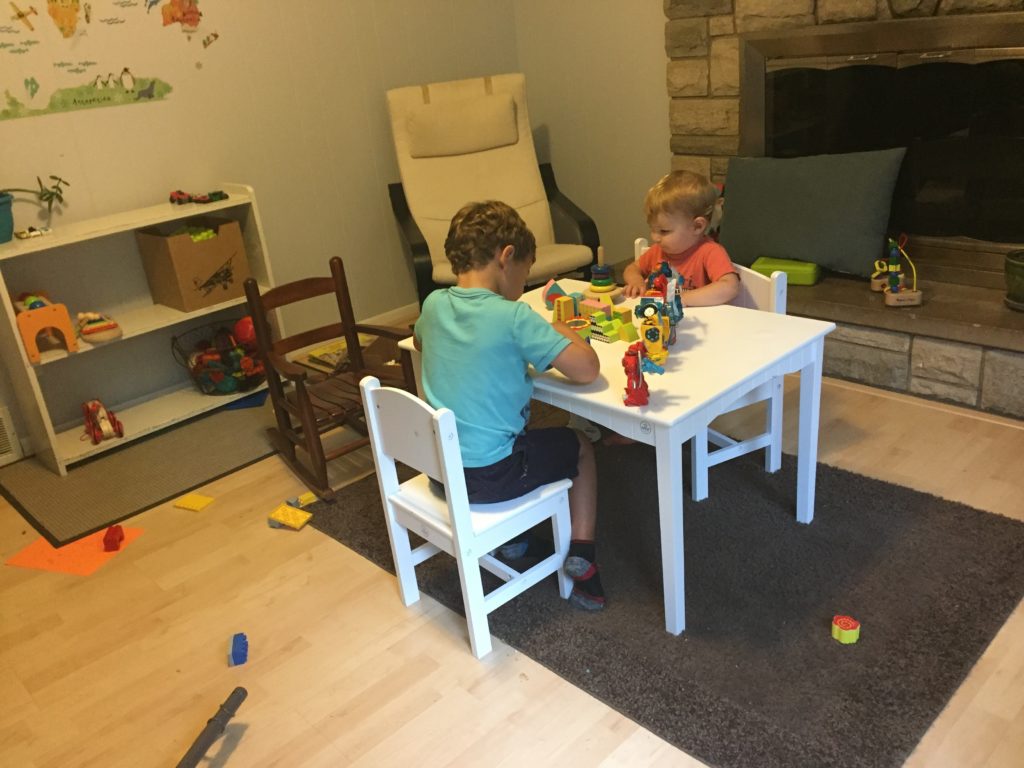
An Inaccessible Shelf to “Hide” Certain Toys
A toy shelf that kids can’t reach makes it easy to rotate toys in and out of play. It also makes it easier for you to limit access to the messiest toys.
If you store rotated-out toys in bins or baskets on the inaccessible shelf, your kids won’t be able to see them every day. That means those toys will be more interesting to kids when you do rotate them back in.
Just make sure to secure all your bookshelves (and other tall/heavy furniture, for that matter) to the wall to prevent terrifying tipping accidents, which have tragically killed precious toddlers in the past.
“Monster” Toy Bins (Bins With Mouths)
In a way, toy bins have similar drawbacks as toy boxes. Both have the same dump-ability, and the bins that are taller than they are wide make it pretty difficult to access toys without a lot of work.
However, you can’t escape bins entirely. You should store things like blocks and miniatures together with the rest of their pieces. And, like I just mentioned, bins make it possible to hide toys that are unattractive or that you don’t want your kids to see all the time.
If you need more than a mere basket to store larger collections of toys, one idea that could work for 2-year-olds is getting a bin that can “eat” the toys back up, like the one shown here. A toy bin with eyes and a mouth essentially transforms the bin itself into a toy, too. Why not make clean-up time into a game for your 2-year-old?
Swoop Bags
I discovered Swoop Bags in my search for a better solution for my kids’ Lego collection.
Swoop, made in Seattle, is a brand of really large drawstring bags that open all the way up into a giant flat circle. The design allows kids to access all the toys in the bag easily without any digging or dumping.
As I mentioned in my post on Lego organization strategy, the super-large Swoop bag of Lego ended up kind of overwhelming my kids. However, it’s perfect for Duplo. I also think the smaller Swoop bags would work well for my kids’ sizeable plastic Transformer collection.
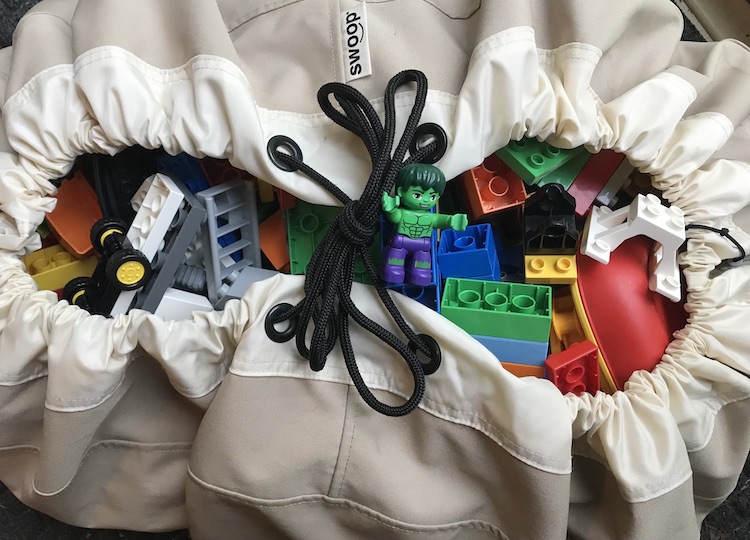
“Bean” Bags
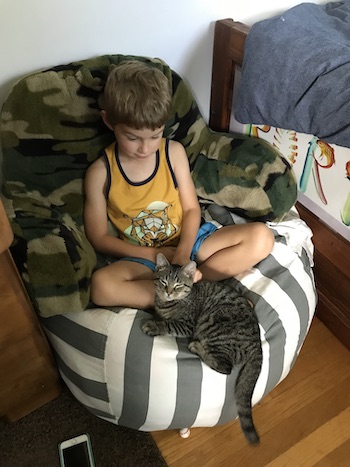
I would be remiss if I didn’t mention this clever toy storage option for stuffies.
When my son started begging for a bean bag, I just couldn’t get behind buying a bunch of styrofoam filling. I knew the foam “beans” would eventually go flat and then spend 500+ years in a landfill. I also didn’t want to shell out for the expensive eco-friendly fill options.
The solution ended up being to store stuffed animals in a bean bag chair cover. It’s not exactly super comfortable (in my opinion), and I had to remove the stuffies with the denser bead-like fills.That said, it’s been working surprisingly well for my boys (who are now in kindergarten and third grade).
My kids don’t play with their stuffed animals much, and we haven’t invested a ton in special ones. So, I didn’t mind that our stuffy collection spends most of their time getting squished.
(Side note: It’s nuts just how many stuffed animals we have accumulated second-hand and as gifts despite the fact that I’ve only ever bought my kids a few! Methinks that hitting up the thrift store and buying up a bunch of stuffies might actually be the best and cheapest way to fill a bean bag for kids.)


